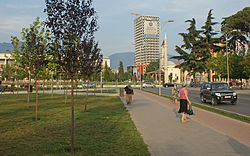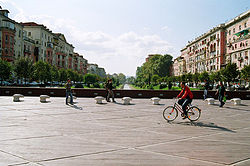Tirana
![]()
Tirona is a redirect to this article. For the Filipino politician, see Emiliano Tria Tirona. For the Spanish folk dance Tirana, see Bolero (music style).
Tirana [tiˈɾana] (definite form of name, indefinite: Tiranë [tiˈɹan]; in the local Ghenish dialect Tirona [tiˈɹɔna] or Tiron [tiˈɹɔn]) is the capital of Albania. The 2011 census recorded a population of 418,495 for the city and 557,422 for the current municipality. According to its own data, Tirana has significantly more, around 625,000 inhabitants (2009), while the agglomeration has 895,042 inhabitants (2008). Together with Durrës and some suburbs, Tirana forms a metropolitan region, where Albania's largest airport and port are also located.
Tirana is the cultural, political and economic centre of a centrally organised state and the seat of several institutions, organisations and parties. Thus, the parliament and the government of the country are located there. Tirana is the capital of the Qark of the same name and, until its dissolution, was also the capital of a district, a large part of which is now part of the Bashkia (municipality) area.
History
Earliest evidence and foundation of the city
The surroundings of Tirana have been inhabited since the Palaeolithic Age. The oldest finds in the city area date back to Roman times: walls and a mosaic from a 2nd or 3rd century Roman villa converted into a church. In the 6th century, the Roman Emperor Justinian I had a fortress built, the walls of which can still be seen in the town centre.
Tirana was first mentioned in its present name in Venetian documents in 1372 and 1418. In 1431/32, the Ottomans carried out a registration of soils and inhabitants in the area for the first time. According to this, there were 60 villages in this region with about 1000 houses and 7300 inhabitants. Marin Barleti in the 16th century distinguished Tyranna maior (Greater Tirana) and Tyranna Minor (Lesser Tirana). In 1583, an Ottoman census for the Tirana region revealed 110 localities, with 20,000 people living in 2900 houses.
The local landowner Sulejman Pasha Bargjini, who came from Mullet near Petrela, built the Sylejman Pasha Mosque, a caravanserai (han), a bakery and a hamam on the present site in 1614 and is thus considered the founder of the city of Tirana. Presumably, a small town with a regular bazaar and fair already existed on this site and had gained in importance, so it was worthwhile to build such an infrastructure for the arriving merchants. After Sulejman's descendants died out around 1800, the Toptani family from Kruja took over the rule of Tirana.
Designation as capital 1920 and first urban development measures
Tirana remained small and insignificant for a long time until it was designated the capital of Albania at the Congress of Lushnja in 1920. Then a place with a few thousand inhabitants quickly became the largest and most important city in the country. King Zogu had a palace built here and with Italian help ministries and a boulevard were constructed. Urban planning measures resulted in the first modern structures, including the central square named after the Albanian prince Skanderbeg.
Dictatorship from 1944 to 1990/91
At the beginning of the Second World War in 1939, Albania was occupied by the Italian fascists.
In November 1941, Enver Hoxha built the Communist Party of Albania in Tirana, and Tirana became the center of the Albanian Communists. They recruited the population to fight against the Italian fascists and the German Nazis. The city was liberated on November 17, 1944, after a heavy battle lasting several days between the partisans and the Wehrmacht, during which many historic buildings - including the most important mosque - were destroyed. A few days later, on 29 November 1944, Hoxha proclaimed the independence of Albania in Tirana.
During the period of communist rule, the city developed rapidly: socialist housing estates and factories - especially food and machine factories - were built. In addition, the communist leadership continued the cultural development of the capital and built numerous educational institutions and cultural centers such as the opera house, several museums, the film studio and several theaters. The University of Tirana was founded in 1956.
In order to be able to redesign the centre of the city, numerous historic buildings were destroyed in the 1960s and 1980s.
Time of democratization
On 20 February 1991, demonstrators toppled the larger-than-life statue of Enver Hoxha in Skanderbeg Square. Thus the end of communist rule was ushered in. Albania gradually began to open up and democratize politically and socially. In March 1997 Albania was again shaken by unrest. Foreigners had to be flown out, as for example in the operation Libelle by the German army.
After democratization, the cityscape changed rapidly. Buildings were illegally erected everywhere, especially towards the northwest. Many inhabitants of the rural regions settled on the outskirts of the city. Shops, cafés and restaurants sprang up in the city centre. From 1999 onwards, the illegal buildings in the city centre were demolished and the green areas restored.
In the 21st century, Tirana experienced an economic boom. Numerous modern high-rise buildings have been built. Most of the streets were newly asphalted and signposted. Many parks were established and many trees were planted. A city and ordinance plan was completed. A sewerage project is being carried out by a Japanese company and large parts of the city have been cleaned up. International companies and shops opened branches. Public transportation has been partially expanded and new city buses have been purchased. A tram project is under consideration. An address system has also been implemented.
On the night of September 21 to September 22, 2019, Tirana was shaken by an earthquake. The quake, measuring 5.8 on the Richter scale, caused damage to at least 300 buildings. Local media stated that over 100 people were injured, some carrying serious injuries. The Albanian ministry spoke of the worst earthquake Albania has experienced in decades.
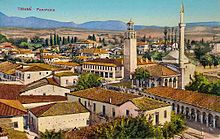
Market centre on a postcard published before 1925
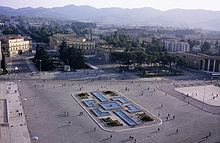
Skanderbeg Square in 1988 - two years before the fall of communist rule
Culture and sights
Tirana is the cultural centre of Albania. It is home to the country's most important cultural institutions and is also where the majority of Albanian artists, athletes, musicians, actors and singers work. However, this was not always the case in Albania. Before Tirana was designated as the capital in 1920, the cities of Shkodra, Korça, Prizren (Kosovo) and Skopje (northern Macedonia) were considered the cultural centres of Albania and the Albanians. It was not until the emergence of Albania's centralized state structure that large city buildings and thus cultural facilities were built in the former small market town of Tirana.
As a result of this centralist policy, but also due to the rural exodus and related immigration from other parts of Albania, the local culture gradually receded into the background, especially in the last 20 years. Tiranian traditions and customs, and local folklore in general, are now known only to a few city dwellers; this culture is now found exclusively in the neighbouring villages.
Theatres, museums and art galleries
Tirana is home to the country's largest museums, art galleries and other cultural institutions. Among the many institutions are the Congress Palace and the Palace of Culture, which houses the State Opera and Ballet Theatre and the National Library. Also centrally located are the National Historical Museum, the National Archaeological Museum, the International Centre for Albanian Archaeology, the National Art Gallery, the Folk Culture Exhibition, the Museum of Natural Sciences and the Armed Forces Museum. The arTurbina Cultural Centre, which opened in 2018 and houses the National Theatre, is located south of the city centre.
Buildings
The city's landmark is the equestrian statue in honour of Skanderbeg on the square of the same name. Also famous is the Et'hem Bey Mosque (built from 1794 to 1821) and the 35-meter high clock tower from 1830 right next to it. Other remains from the Ottoman period are rare. The Ottoman stone arch bridge Ura e Tabakëve from the 18th century with the mosque of the same name and the walls of the castle, some of which even date back to Justinian times, have been preserved. The Kapllan Pasha Turbe is also part of the Ottoman cultural heritage, as are the Kokonozi Mosque and the Sheikh Dyrri Tekke.
Among the most important sights in the vicinity of Tirana is the Petrela Fortress on the road to Elbasan, built in the early Byzantine period. Another important fortress is located in Preza.
In the 1930s and 1940s, the main building of the university and an ensemble of administrative buildings were built in the style of Italian fascism. The beautiful city villas, which were also built during this period, have had to make way for modern high-rise buildings in recent years. Building land is scarce and expensive in downtown Tirana.
Known as Piramida, the former Enver Hoxha Museum is located south of the Lana; it is a communist-era building that opened in 1988 as a museum dedicated to dictatorial leader Enver Hoxha. His daughter Pranvera had the pyramid designed and built. Today the building is used for conferences and trade fairs; it is also home to the Top Channel television station.
Architecture
The architecture is partly Balkan traditional, partly interwar fascist (neoclassical), but for the most part characterized by prefabricated buildings, newer apartment buildings and - especially in the northwest - by illegal settlements. The Pallati me kuba is one of the few examples of modern building from the communist era. Tirana has been experiencing an economic upswing for some years now, as evidenced by the large amount of construction activity.
The facades of entire streets in the city centre were redesigned a few years ago in garish colours and wild patterns. These "painting actions" by the mayor and artist Edi Rama alleviated the communist dreariness that clung to many a prefabricated building and many unplastered houses. Other cities in Albania also adopted this idea from Tirana.
However, since these first transformations at the beginning of the 21st century, the cityscape has continued to change greatly. Modern new buildings, new avenues, schools, roads, cycle paths, parks and a new sewage system have been created, and the supply of electricity and water has also improved greatly.
Downtown
The city's focal point is Skanderbeg Square, circled by the National Historical Museum, the Tirana International Hotel, the Palace of Culture, the Et'hem Bey Mosque and the clock tower behind it, and the TID Tower, the fascist-era ensemble of buildings - to the west of which are still the Puppet Theatre, the Socialist Party headquarters and the Albanian Orthodox Cathedral of the Resurrection - and the Bank of Albania (rotating clockwise from the north).
From Skanderbeg Square, the main streets of the city go in a star shape in all directions. Boulevard Dëshmorët e Kombit is the central axis and leads in a southerly direction past the Ministry of Interior and Defense, Rinia Park, the National Art Gallery, Hotel Dajti, across the Lana, past the Pyramid of Hoxha, Lulishtja e tre vëllezërve Frashëri Park, the Twin Towers, further past the Council of Ministers, the seat of government, the Rogner Hotel, the Qemal Stafa Park, the seat of the President and the Congress Palace to Mother Teresa Square with the University, the Polytechnic University and the University of Arts, as well as the Qemal Stafa Stadium, which is slightly set back. North of the stadium is the ABA Business Center and south of that is the Sheraton Hotel at the bottom of the small hill, upon which is the Great Park (Parku i madh). There is a German military cemetery in the park. Behind the artificial lake there are also the Botanical and Zoological Gardens.
The Blloku west of the central boulevard, was a villa district, which was inhabited before the democratic change only by the higher leadership politicians, including Enver Hoxha. In recent years, numerous cafés, trendy bars, chic restaurants, boutiques, office buildings and skyscrapers such as the Sky Tower with its revolving restaurant have sprung up here in a very confined space. Today, the district is often referred to as the playground of the young elite.
Further west is the Komuna e Parisit district with numerous modern high-rise buildings and the Selman Stërmasi stadium.
In addition to numerous green spaces in the city centre, the Great Park south of the university invites you to linger. It borders on the artificial lake, next to which the municipal swimming pool is located. In earlier times, the park was the site of the Orthodox Church of Shën Prokopi. The atheist communists imposed a total ban on religion in 1967 - a restaurant was built on the site of the church. After the introduction of democracy, the building was converted back into a church.
East of the boulevard on the north bank of the Lana is the Catholic Cathedral of St Paul (alb. Shën Pali). Further east is an old Ottoman stone bridge that crosses the Lana (Ura e Tabakëve). The city's largest food market, Pazari i ri, is located east of Skanderbeg Square around Avni Rustemi Square.
Northwest of Skanderbeg Square is Sheshi Karl Thopia (formerly Sheshi Zogu i Zi), where the highways to Durrës and Shkodra begin.
Leading north from the central Skanderbeg Square is Zogu I Boulevard. , which is lined with many boutiques and restaurants. The street ends at Sheshi Franc Nopca square, where the Tirana station of Hekurudha Shqiptare used to be. An extension to the north is currently (2014) being worked on.
Outskirts
In the Lapraka district of northwest Tirana is the largest hospital in Albania, called Spitali Ushtarak - "Military Hospital". The University Hospital stands next to the Military Academy "Skanderbeg" northeast of Skanderbeg Square.
In the very southwestern tip of the city is the Kombinati district, once a large industrial area with many factories and businesses and many homes for the workers.
In the Heroes' Cemetery on the southeastern outskirts of the city stands the monument Mother Albania (Nëna Shqipëri).
Sports
The three football clubs KF Tirana, KS Dinamo Tirana and FK Partizani Tirana are among the most successful clubs in the country: Tirana leads the list of record champions in the Albanian championship Kategoria Superiore, ahead of Dinamo and Partizani. Tirana and Partizani have won the cup the most times, ahead of Dinamo. However, currently only KF Tirana and Partizani play in the highest division. The football teams play their home matches at the Selman Stërmasi Stadium and the Air Albania Stadium, the national stadium.
For indoor sports such as basketball and volleyball, Tirana has the larger Arena Pallati i Sportit "Asllan Rusi", which served as a refugee shelter during the Kosovo war in 1999. Equally used at the time was the large outdoor swimming pool on the outskirts of the city, which has been renovated and is now the largest outdoor swimming pool in Albania.
Folklore
Tirana has a rich traditional folklore that is popular throughout Albania. The city is one of the centers of Central Albanian music, songs, dances and costumes. Famous performers of Tirana's typical folk music include Merita Halili, Manjola Nallbani, Valbona Mema, Hafsa Zyberi (1925-1994) and Fitnete Rexha (1933-2003).
The musical style of the local folk culture is mainly characterized by the sounds of the clarinet and the accordion, and the rhythm of dajre and tupan. Very similar musical styles prevail throughout the Central Albanian region around Durrës, Kavaja, Kruja and Elbasan.
Every year on March 14, the pagan spring festival Dita e Verës is celebrated in various streets and squares of Tirana.

Air Albania Stadium in Tirana .
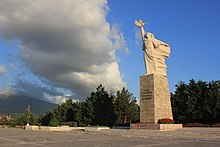
Monumental statue Mother Albania

Skanderbeg Square with the Et'hem Bey Mosque and the ensemble of buildings of the ministries
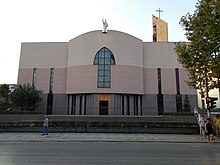
Roman Catholic Cathedral of St. Paul, on Zhan D'Ark Boulevard, on the banks of the Lana River
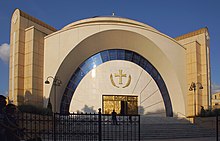
Katedralja orthod. Ngjallja e Krishtit, sacral building at the Rruga Ibrahim Rugova, Tirana (Photo 2014)
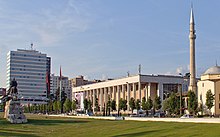
Skanderbeg Square with Opera House, Cultural Centre and National Library, equestrian statue of Prince Skanderbeg and Et'hem Bey Mosque (2014)
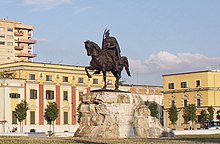
Equestrian statue of Prince Skanderbeg from 1968 (photo 2014)

The clock tower is one of the landmarks of the city.
Search within the encyclopedia
